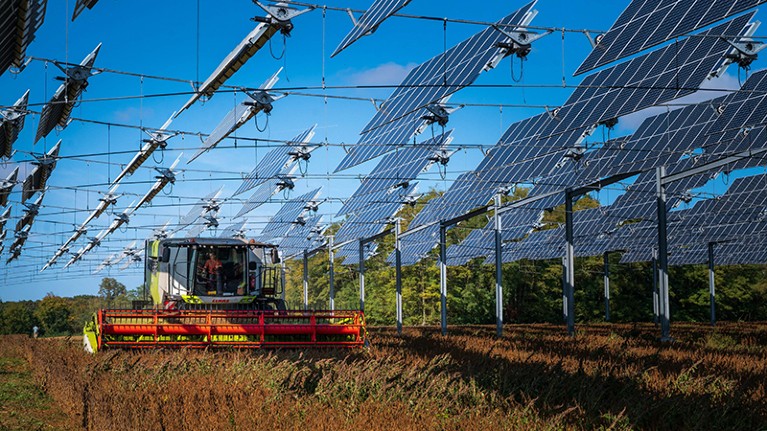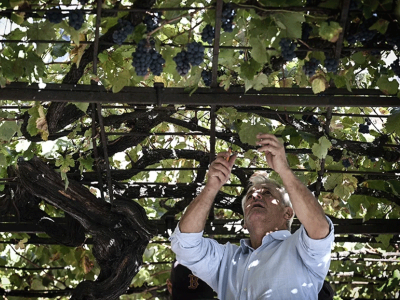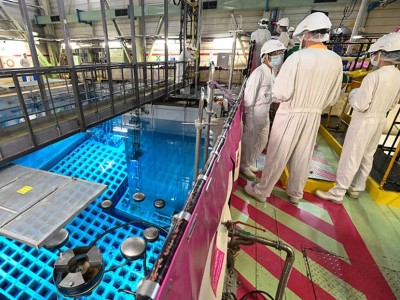
A farmer drives a combine harvester under hanging solar panels on an agrivoltaic site in Amance, France.Credit: PATRICK HERTZOG/AFP via Getty
In March 2023, the French government passed a law requiring all solar projects on farmlands to provide some sort of service to agriculture: from improving yields to protecting crops from frost or heatwaves. The decree, entitled ‘On Accelerating the Production of Renewable Energies’, hopes to address a rising call to protect agriculture from an increase in the amount of land being used to harvest solar energy rather than crops.
This trend has become common, thanks to the shrinking costs and growing profitability of the photovoltaic technology behind solar panels. In France, a landowner could make between 10 and 100 times more money per hectare renting out their land to an energy company than they’d make from conventional farming. This puts the future of agricultural land at risk.
The bill hopes to build a compromise — aiming to meet the demands from energy companies to install solar panels, without damaging the yield of land used for food production. More laws on the issue are being drafted, including one that specifies the penalty that landowners might face for not meeting productivity targets.
The government’s target to generate 100 gigawatts of solar power by 2050 looms large in discussions, but in a country where the agricultural lobby holds immense political power, any debate is fraught with political tensions. Furthermore, the changing balance between market forces in France might signal economic shifts elsewhere. As solar projects get cheaper to build, and as many of the world’s economies cry out for more renewable energy, how will conventional farmlands cope?
And ongoing protests by farmers across Europe, particularly in France, might affect the coming debates around the use of solar technologies on farmland. Distrust of the new rules, as well as calls for better prices and access to affordable farmland, have fuelled the strikers’ outcry.
Changing old viticulture for all the right rieslings
According to the French Agency for Ecological Transition, solar projects contributed 16 gigawatts to the French grid in 2022. So far, only 1.3 gigawatts is expected to come from photovoltaics built on agricultural enterprises, some of which are still under construction. Around 61.4 gigawatts(45% of the country’s electricity) comes from nuclear power. Today, renewable energies account for only 20% of the total energy consumed in France, and the government has pledged to reach 33% by 2030. It also plans to comply with the more ambitious European Union’s target of 42.5% of energy from renewables by 2030.
French researchers have been investigating how solar panels can be installed without damaging the growth of crops for decades. Farms make up half of France’s land, by far the easiest host for solar-power projects compared with the urban regions, forests or protected natural areas that blanket the rest of the country.
Christian Dupraz and his team of agronomists at the French National Research Institute for Agriculture, Food and Environment (INRAE) in Montpellier research the benefits of temporary shade for plants, and how solar-based systems can help. In Occitania, in the south of France, the team has been experimenting with various ways of mitigating harsher temperatures caused by global warming. Shade structures equipped with solar panels are part of one such technique. With this system, nicknamed agrivoltaic by Dupraz, panels rise over crops to protect them from sunlight when required, rather than simply replacing farmland acreage.
“Crops don’t use all the Sun’s rays. Their needs depend on life cycle, and some stages — such as grain filling and end of the production cycle — need less light than others,” Dupraz says. The panels also provide protection against weather hazards that come and go, such as night frosts, hail and heatwaves. The technical challenge is therefore to create structures that can harness the Sun’s energy as well as being smart enough to adapt to the needs of the crops growing beneath them.
Agronomical tracking model
Several companies are working on these models, including Sun’Agri, based in Lyon, France, which has operated a joint research programme with Dupraz’s team for more than ten years. Damien Fumey, an agronomist at Sun’Agri, says that fields in southern France equipped with mobile solar panels saw increased yields in perennial crops such as vines or fruit trees.
INRAE also created a national cluster of 56 partners, including energy companies, for agriphotovoltaic research in February 2023. The director, agronomist Abraham Escobar-Gutiérrez, points to a 2023 Applied Energy publication1, which concluded that lucerne crops (Medicago sativa) — beansprout-like plants — alongside mobile panels showed slightly higher yields than those elsewhere, thanks to reduced evapotranspiration and the plant’s adaptation to shaded conditions.
Why France’s nuclear industry faces uncertainty
Although the agriphotovoltaic model seems to be an attractive compromise on the surface, it’s less appealing to the energy industry, because it produces lower electricity yields than do panel systems, which simply prioritize their placement to the Sun. Critics also point to the costs of such systems. Escobar-Gutiérrez estimates that a sophisticated agronomical tracking system is ten times more expensive than a standard solar farm.
Another battle rages around the proportion of land that can be covered by solar panels. Energy companies are lobbying the French government to legalize covering up to 40% of farm plots in solar panels, in the name of the profitability. Agronomists counter that anything more than 25% will jeopardize agricultural production. Dupraz says that “by accepting a high coverage of panels while forbidding agronomic losses, the law could be unenforceable”.
Japan — another country attempting to find a balance between sustainable agriculture and a green electricity transition — has chosen to regulate yield losses rather than land coverage. Since 2013, Japanese regulations have required farmers with solar panels in their field to comply with a yield reduction of less than 20% compared with the average yield of the surrounding farmland. Christian Doedt, a researcher at the Institute for Sustainable Energy Policies (ISEP) in Tokyo, says that Japanese farmers have concerns regarding this rule, especially about the threat to those who don’t comply. “The yield requirement of 80% and the legal possibility of dismantling agrivoltaics projects that don’t fulfil it are still a huge barrier to the expansion of agrivoltaics in Japan,” Doedt says.
Fighting for the light
And although legislation is being drafted, for some farming areas it is already too late. As solar panels started to become commercially affordable around 2000, many of the vast greenhouses that grew fruit and vegetables in France’s farmlands got kitted out with them by enterprising farmers. In 2018, the local authorities of the French department of Pyrénées-Orientales estimated that two-thirds of the greenhouses equipped with photovoltaic panels had been completely emptied of crops.
Therapy dog spreads paws-itivity at cancer hospital
Last year’s law aims to redress the balance and prevent this from occurring in the future. “Before the law of 2023, photovoltaic projects in agriculture were highly disparate across the country, with some local authorities allowing all projects to go ahead, and others systematically blocking them in the name of agriculture. The law is trying to find a bridge between the two,” explains Benoit Grimonprez, rural-law researcher at the University of Poitiers, France. Escobar-Gutiérrez says that he ‘is optimistic’.
Whereas France and Japan’s regulatory approaches are motivated by protecting the quality and supply of food, a different market-driven trend is emerging in the United States and Germany, supported by the energy lobbies that want to have access to land at the lowest cost, says Dupraz. Germany accepts a one-third loss of yield in farms with solar-panel systems. But further legal and economic battles might arise in the coming years in countries with similar conflicts about land use.
In some countries, there’s space for everyone. “The situation is different in countries with large uncultivable and unproductive areas, such as Spain and the USA,” Dupraz adds.

 Changing old viticulture for all the right rieslings
Changing old viticulture for all the right rieslings
 Why France’s nuclear industry faces uncertainty
Why France’s nuclear industry faces uncertainty
 Therapy dog spreads paws-itivity at cancer hospital
Therapy dog spreads paws-itivity at cancer hospital



![High carrier mobility along the [111] orientation in Cu2O photoelectrodes](https://media.nature.com/w140h79/springer-static/image/art%3A10.1038%2Fs41586-024-07273-8/MediaObjects/41586_2024_7273_Fig1_HTML.png)




